Overview: a brief history of Woolworth in Germany
Proud of its value heritage and fit for the future
Frank Woolworth's first visit to Germany in 1890
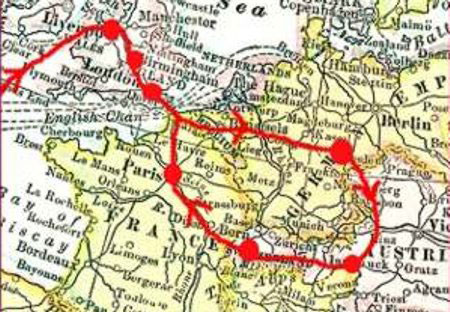 By 1890 Woolworth had established a friendly rival network of over 100 5¢ & 10¢ stores in North America with a group of former co-workers and had built a reputation for outstanding value and stores that attracted huge crowds. His USP was to buy directly from factories cutting out the wholesalers. He offered up-front cash for huge orders of a small number of lines, to be shipped to his central warehouse, helping his achieve an ultra=low cost price. As copycat chains started to emerge, he looked further afield to broaden his range. A friend offered to introduce him to the world's most modern, automated factories, in England, France and Germany. The buying trip took over four months and became a key driver of the chain's success
By 1890 Woolworth had established a friendly rival network of over 100 5¢ & 10¢ stores in North America with a group of former co-workers and had built a reputation for outstanding value and stores that attracted huge crowds. His USP was to buy directly from factories cutting out the wholesalers. He offered up-front cash for huge orders of a small number of lines, to be shipped to his central warehouse, helping his achieve an ultra=low cost price. As copycat chains started to emerge, he looked further afield to broaden his range. A friend offered to introduce him to the world's most modern, automated factories, in England, France and Germany. The buying trip took over four months and became a key driver of the chain's success
According to his diary, Frank Woolworth loved thhe peace and solitude of Frankfurt's Cathedral and he really regretted not being able to speak German and having to rely on interpreters or English-speaking suppliers. Among the treasyres that he bought for the five-and-ten were fine porcelain cups and saucers from Mysen to sell for 10¢ colorized printed postcards using a team of artists and a super-fast 100x150mm double-sided press, from a supplier who would take photographs or line drawings by American artists, colour and reproduce them as postcards which they would supply for just over 1¢ each and which he believed he could sell for 5¢ for the best designs and two for 5 ¢ for the rest.
 His other favourites were toys, particularly dolls made in many home-based businesses dotted around Sonneberg, and glass blown Christmas Decorations, in shapes like Owls, Smoking Pipes, Santa Clauses and Musical Instruments. He set up a warehouse in Sonneberg which offered to pay cash for a gross of any of his approved lines that matched a basic agreed speicification. Between 1890 and 1914 it is estimated that Woolworth sold more 250 million German made pieces in the USA. By the twentieth century imported goods from Europe accounted for over 25% of his range and 40% of the profit generated by the Syndicate in North America.
His other favourites were toys, particularly dolls made in many home-based businesses dotted around Sonneberg, and glass blown Christmas Decorations, in shapes like Owls, Smoking Pipes, Santa Clauses and Musical Instruments. He set up a warehouse in Sonneberg which offered to pay cash for a gross of any of his approved lines that matched a basic agreed speicification. Between 1890 and 1914 it is estimated that Woolworth sold more 250 million German made pieces in the USA. By the twentieth century imported goods from Europe accounted for over 25% of his range and 40% of the profit generated by the Syndicate in North America.
Foundation of the Germany Subsidiary in 1926
In 1924 the F.W. Woolworth Co. chairman, Charles Sumner Woolowrth, the brother of the Founder, travelled to Europe with his Finance Director and Vice-President responsible for overseas operations, Byron De Witt Miller. The two wanted to visit the elegant new stores opened by the British subsidiary in two prime shopping streets in Central London to rival the parent's branches in Fifth Avenue, New York and State Street, Chicago, before crossing to Europe to explore the viability of a plan developed by Miller to open a subsidiary in Germany, intially to bolster the supply chain for European Goods for export to New York, and later to test the market and assess the viability of a chain of 25 und 50 Pfennig Stores across the Weimar Republic.
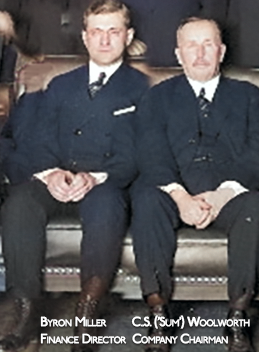
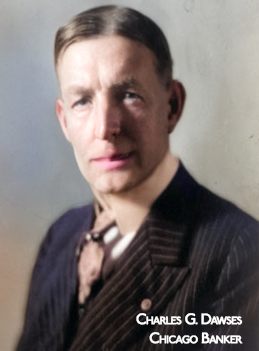 Miller had been drawn to Germany by the Chicago Banker, Charles G. Dawes, who had been tasked with fixing the country's economy so it could resume the reparations imposed after losing the Great War. He wanted US firms to invest there. The FD had been grappling with how to boost the efficiency of FWW's German sourcing which was missing Frank Woolworth's guiding hand. Miller felt a German subsidiary could map a global supply chain by rebuilding the warehouse in Sonneberg and updating Fuërth, before shaping a new store chain for the Weimar Republic.
Miller had been drawn to Germany by the Chicago Banker, Charles G. Dawes, who had been tasked with fixing the country's economy so it could resume the reparations imposed after losing the Great War. He wanted US firms to invest there. The FD had been grappling with how to boost the efficiency of FWW's German sourcing which was missing Frank Woolworth's guiding hand. Miller felt a German subsidiary could map a global supply chain by rebuilding the warehouse in Sonneberg and updating Fuërth, before shaping a new store chain for the Weimar Republic.
Miller and Woolworth were certain that the brand would strike a chord with Germans, particularly if it followed the pattern of Frank's early Stateside shops, which had concentrated on everyday essentials at jaw-drop prices for the home, kitchen and bathroom, along with notions (Haberdashery) and simple stationery. Any displays of ornaments, toys and luxuries would be kept small until family incomes started to grow as the economy improved. They feared that they would meet with resistance from Company President, Hubert Parson, even though he was well aware that German shops had been his former boss and mentor's dream. Returns were falling at home, making the parent increasing dependent on profits from the UK, prompting Parson to keep capital spend down.They would have to convince him that Germany was the answer to his prayers.
Launch of the F.W. Woolworth 25 und 50 Pfennig Stores
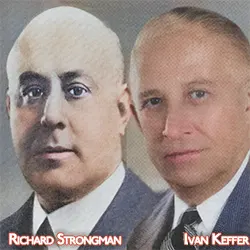
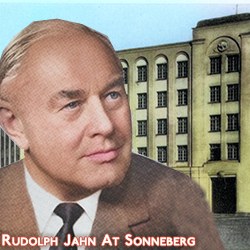 Parson gave in, making German-American executive Richard H. Strongman the first Geschäftsführer (MD) as proposed. He duly incorporated the company in 1926 and hired its top team, choosing locals Ivan W. Keffer as his No. 2, and Rudolph Jahn, who had trained at FWW USA before taking a role at its Sonneberg Warehouse in Germany when it opened in 1920. The three reimagined that facility as the super-efficient hub for New York's global sourcing and oversaw the work.
Parson gave in, making German-American executive Richard H. Strongman the first Geschäftsführer (MD) as proposed. He duly incorporated the company in 1926 and hired its top team, choosing locals Ivan W. Keffer as his No. 2, and Rudolph Jahn, who had trained at FWW USA before taking a role at its Sonneberg Warehouse in Germany when it opened in 1920. The three reimagined that facility as the super-efficient hub for New York's global sourcing and oversaw the work.
Once reconstruction began, the Directors scouted the country, visiting each major town and city in turn and applying the time-served process defined by Frank Woolworth. It measured the amount of foot traffic on the main streets, the current and forecast population and the key industries to determine which places would suit a Woolworth's and whereabouts in town it should be. Normally the chosen spot was near a transport hub, close to other shops and in a town or city with manufacturing and heavy industry or docks and freight yards employing lots of people. As they travelled, it was clear that Germany was ready and had huge potential. When a town fitted, before leaving they searched for any vacant buildings near their chosen spot, or failing that tried to persuade an extisting trader to sell-up and retire. With the tour complete they pulled together a masterplan for the openings. The new chain would be a birthday present for New York, as 1927 marked the Fifteenth Anniversary of its Wall Street listing in the $65m merger. They advised Executives to tell investors, "Here we grow again."
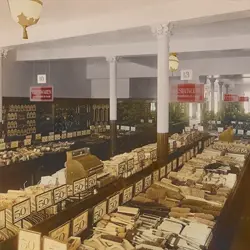
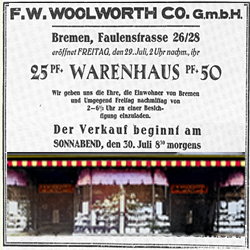 New York approved the plans as written, instructing "proceed without delay". The northern port city of Bremen was 'Ground Zero', quickly followed by Barmen, Bochum, Wiesbaden, Dortmund, Hamborn, and Duisburg, finishing in Berlin within a year. Six months after the sign-off, a marching band and orchestra welcomed customers to a preview at 26-28 Faulenstrasse at 2.30pm on Friday 29th July, 1927. Trading began at 8.30am the next day, and broke all records. Larger view..
New York approved the plans as written, instructing "proceed without delay". The northern port city of Bremen was 'Ground Zero', quickly followed by Barmen, Bochum, Wiesbaden, Dortmund, Hamborn, and Duisburg, finishing in Berlin within a year. Six months after the sign-off, a marching band and orchestra welcomed customers to a preview at 26-28 Faulenstrasse at 2.30pm on Friday 29th July, 1927. Trading began at 8.30am the next day, and broke all records. Larger view..
For five years the new-born company was Woolworth's wonder-child, expanding its chain, sales and profit far faster than any country had achieved before. Directors later described the period as "Der große Errfoig, or "The Great Success". But then the bubble burst. Intense competition from fixed price shops had disrupted the market. It came not only from Woolworth but from look-alikes, Epa, Ehape and Wohlwert (craftily named how most Germans would naturally pronounce the name above FWW's door). It spooked both the competition, and a rapidly-rising popular politician who hated foreign firms taking trade from Germans and sending the profit home. His name was Adolf Hitler. In 1932 the Reichstag, Germany's parliament, passed a law banning fixed priced stores from opening any more outlets. MD Strongman was able to use Woolworth's huge supplier base, cash purchases of goods for export to New York, and projects already in progress, to obtain a temporary exemption until the end of the year, when he chose to retire. He passed the baton to his number two, Ivan Keffer on 1 January 1933, the day the firm moved into plush new offices in Bellevuestrasse II, Berlin, W.9. The new Geschäftsführer faced a rocky road ahead, particularly after the Reichstag mysteriously burnt down in July, completing Hitler's rapid rise to absolute power and the supremacy of his National Socialist Party.
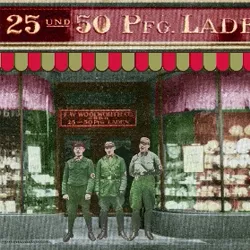
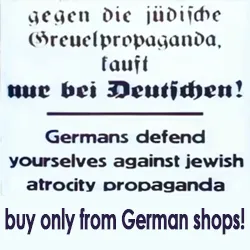
New York was unimpressed when Ivan Keller sent an enquiry from the Commerce Ministry asking if any Director in New York or Berlin was Jewish. They replied that their Board consisted of Methodists, along with two Catholics and a pair of aetheists. Berlin could answer for itself. Keffer duly updated the Ministry, receiving a terse acknowledgement for his satisfactory if rather tardy response.
But the protestors outside his largest stores didn't disperse. They simply swapped one set of placards for another. Instead of protesting about possible Jewish management, the new signs advised Germans to buy only from German shops and not to be taken in by Jewish propaganda about atrocities. Keffer's problems didn't end there. Every week there seemed to be new rules restricting his freedom to act and manage the business. By the end of 1935 he could not allow cash from F.W. Woolworth G.m.b.H. to leave the country, except in payment for approved imported goods. Returning profits to a parent company was explicitly prohibited by law. Foreign-owned companies were required by law to deposit any surplus cash in German-owned banks or invest it in German-owned businesses.
By 1938 the parent company had sacrificed more than fifteen million reichsmarks ($6m) in unpaid dividends and thought it best to move their loyal MD, Ivan Keffer, who had repeatedly riled the German authorities, out of harm's way to the Executive Office HQ in Toronto, Canada. They tried to place control of most aspects of German operation in the hands of their local lawyers, but the arrangement did not meet with approval from the authorities, which instructed Rudolph Jahn, rated a loyal citizen, to take the helm. It fell to him to chart a way forward. He had to try to maintain morale as the nation went to war, keep trading as shopping streets faced enemy bombardment, and after the Allied victory in 1945 put it all back together, a piece at a time. By the time the conflict finally ended, both warehouses and the great majority of stores had been obliterated from the face of the earth, forcing New York to reduce the value of the subsidiary to a single dollar in its accounts. Jahn led the firm with great skill and resolve for over a quarter of a century. When he retired in 1964 he had served forty-five years as an Executive, including 39 as a Director and 26 as MD. Across the globe no other individual, not even the Founder, faced and mastered more challenges in office. Jahn richly deserves his place in the Woolworth Hall of Fame.
Rebuilding and reshaping after World War II
This short film, which draws on the German company's 1963 history which was published as memento for Managers and Staff by the long-service Managing Director Rudolph Jahn in 1963 shortly before his retirement after 44 years exemplary service, shows the regeneration of Woolworth after World War II as a larger and more upmarket department store chain. For our German visitors we have added a commentary in German. English subtitles are also available if enable captions in your HTML5 compatible browser.
The video is presented in HTML5 with video.js. Closed captions are available by clicking the 'CC' button,
if you have enabled that eature enabled in your browser.
1997: German MBO as the shutters fall in the USA
Emergency surgery fifteen years earlier had failed to save US Woolworth
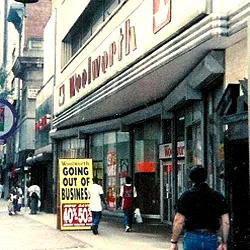
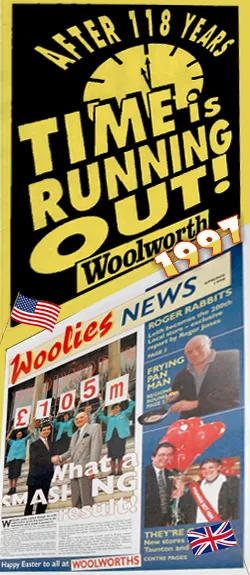 After 1982 most leaders made heavy cuts to Woolworth in the US. But a couple preferred to seek a turnaround, trying a hybird Woolworth Express format, new IT, a reshaping in Hawaii, and in 1996 outsider Roger Farrah tested a statewide rebrand in Delaware. In 1997 the CEO admitted defeat. Trial store sales and profit were well up, but returns per dollar invested were only a third of the level achieved by Footlocker. He had concluded that it was time for Woolworth to retire with grace and honour after 118 years.
After 1982 most leaders made heavy cuts to Woolworth in the US. But a couple preferred to seek a turnaround, trying a hybird Woolworth Express format, new IT, a reshaping in Hawaii, and in 1996 outsider Roger Farrah tested a statewide rebrand in Delaware. In 1997 the CEO admitted defeat. Trial store sales and profit were well up, but returns per dollar invested were only a third of the level achieved by Footlocker. He had concluded that it was time for Woolworth to retire with grace and honour after 118 years.
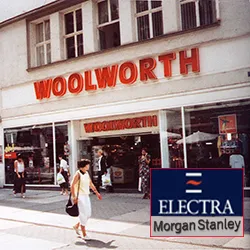 The Company would "do right by its people". They would have time to say good-bye. Where possible a sister brand would take on the premises to save jobs. Everyone else would get enhanced severance, outplacement support and members the chance to draw their pensions early. He would also find a way of helping the German and Mexican Boards to launch buyouts. They were profitable and self-sufficient and could continue. Americans were shocked at losing the iconic " 5 and 10¢". But most observers acknowledged that the exit was handled with kindness and sensitivity.
The Company would "do right by its people". They would have time to say good-bye. Where possible a sister brand would take on the premises to save jobs. Everyone else would get enhanced severance, outplacement support and members the chance to draw their pensions early. He would also find a way of helping the German and Mexican Boards to launch buyouts. They were profitable and self-sufficient and could continue. Americans were shocked at losing the iconic " 5 and 10¢". But most observers acknowledged that the exit was handled with kindness and sensitivity.
2007: Acquisition by UK/US Venture Capitalists
2009: caught in the crossfire during the Credit Crunch
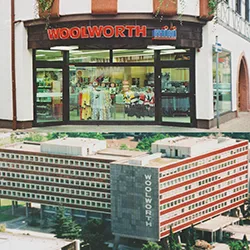 In 1997 the American Woolworth President Roger Farrah arranged for two merchant banks to finance a Management Buy Out of the German Subidiary by its Board, with the bankers getting most of the shares, and the services of the existing Directors secured for a period of five years by generous golden handcuffs which they could cash five years after the split if the company had survived and prospered. With the exception of the Directors who reached the Company's retirement age in the decade after the split, the others remained in post, keeping the same basic stucture, including a huge central administration department in Frankfurt that had matched the structure in the USA, and continuing the move upmarket that had built pace since World War II, opening a series of new, smaller convenience stores called Woolworth-Miniin Germany's smaller towns. Customers were prepared to pay a premium to get access to chain store brands without having to travel to a major shopping centre.
In 1997 the American Woolworth President Roger Farrah arranged for two merchant banks to finance a Management Buy Out of the German Subidiary by its Board, with the bankers getting most of the shares, and the services of the existing Directors secured for a period of five years by generous golden handcuffs which they could cash five years after the split if the company had survived and prospered. With the exception of the Directors who reached the Company's retirement age in the decade after the split, the others remained in post, keeping the same basic stucture, including a huge central administration department in Frankfurt that had matched the structure in the USA, and continuing the move upmarket that had built pace since World War II, opening a series of new, smaller convenience stores called Woolworth-Miniin Germany's smaller towns. Customers were prepared to pay a premium to get access to chain store brands without having to travel to a major shopping centre.

In 2007 the Board was approached by a group of Venture Capitalists with a speculative bid to buy the Company and take it private at a price which would reward the existing Directors for their success in establishing the company after the split and would also give the bankers from Electra and Morgan Stanley to see a very good return on their investment. The offer, made jointly by Argyle Capital Partners of London and Cerberus Capital of New York, was accepted in October 2007. The new owners had a thorough plan for streamlining the business, tidying its property porfolio and accelerating the most lucrative elements of its modernisation programme.
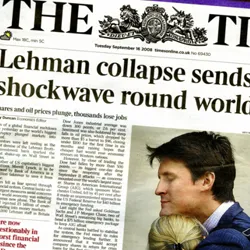 The collapse of Leham Brothers on September 15, 2008 sent shockwaves around the globe. Soon banks stopped lending to each other, let alone to new businesses or existing clients wanting more credit. One of the early casualties was Woolworths in the UK, which became the icon of the credit crunch, The story of its debts and the way it was believed to have hoodwinked its asset-based lenders became a widely quoted cautionary tale of how not to run your business.
The collapse of Leham Brothers on September 15, 2008 sent shockwaves around the globe. Soon banks stopped lending to each other, let alone to new businesses or existing clients wanting more credit. One of the early casualties was Woolworths in the UK, which became the icon of the credit crunch, The story of its debts and the way it was believed to have hoodwinked its asset-based lenders became a widely quoted cautionary tale of how not to run your business.
It had run out of cash partly because of extravagance but mainly because the credit insurers who provided a niche service to suppliers that is largely unknown outside the retail trade, decided to withdraw cover after hearing stories of how the firm had misled its lenders and the London Stock Exchange. Suddenly instead of getting free credit for around six weeks on the majority of its goods - long enough to sell them and bank the cash - major suppliers started to demand payment upfront, quickly emptying the coffers. Many believe they went on to withdraw cover from the German company just because of its name, without exploring its plans or credit-worthiness at all. Others say that the new owners turn around plan was misconceived in moving so far upmarket.
In either case the owners soon had to seek bankruptcy protection. German law follows the American model, affording a period of protection from creditors to allow a business to reorganise and restructure to save jobs. This gave time for a white knight to emerge with a plan to salvage a sizeable part of the business. The family-owned value retailer Tengelmann offered to save around 150 stores in larger towns and cities and sharpen their value proposition. It would also cut overhead costs by closing the huge and expensive administration office complex in Frankfurt and intially would use its existing Buyers and Suppliers to get back trading again quickly. The new owner was unable to save the recent mini=Woolworth stores or some of the largest, most, expensive buildings. Those stores did not have the footfall to justify the higher operating costs. The revived chain would offer a great value selection of items for the home, fashions for all the family, stationery and seasonables. Once the formula was proven it aimed to expand rapidly to locations in larger towns and cities across Germany and beyond, with an aspiration to grow to over five hundred outlets over time, which would make Woolworth the largest it had ever been in Germany. Despite economic challenges in Germany and the pandemic, the makeover has consistently hit its targets, with the chain's store base, profit and customer traffic growing at a rapid rate while most other retailers have been in decline. In parallel with the openings programme it has established a new company culture, developing its own talent to support the opening programme, along with an ultra-efficient central administration and supply chain hub in Unna, with plenty of room to grow.
February 2024: "here we grow again"
The slogan from 1927 is even more appropriate today
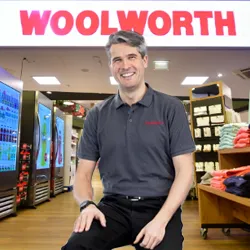
Woolworth Germany has gone from strength to strength since Roman Heini took the helm in 2020. Today the company has 620 stores in Germany - more than ever before - with around twenty more in Austria and Poland. Today's branches carry around 10,000 lines, over 90% of which are own-brand and made to the Company's own specification. 6,000 of the lines cost €3 or less (£2.67), comprising mainly goods for the home, stationery, clothing basics for all the family and a selection of toys. The Company expects to break through €1 billion sales this year. In January 2024 Heini told Retail Week that the Company had recently acquired the rights to trade across Europe, including the UK and Ireland. He believes the Continent could support up to 5,000 Woolworth outlets in the future, and teased journalists that his pipe dream for the medium to long term is to re-open in the UK, where brand recognition remains exceptionally high. The Woolworths Museum wishes him every success in bringing that dream to reality as soon as he can. We can't wait.